Family : Muraenidae

Text © Giuseppe Mazza

English translation by Mario Beltramini
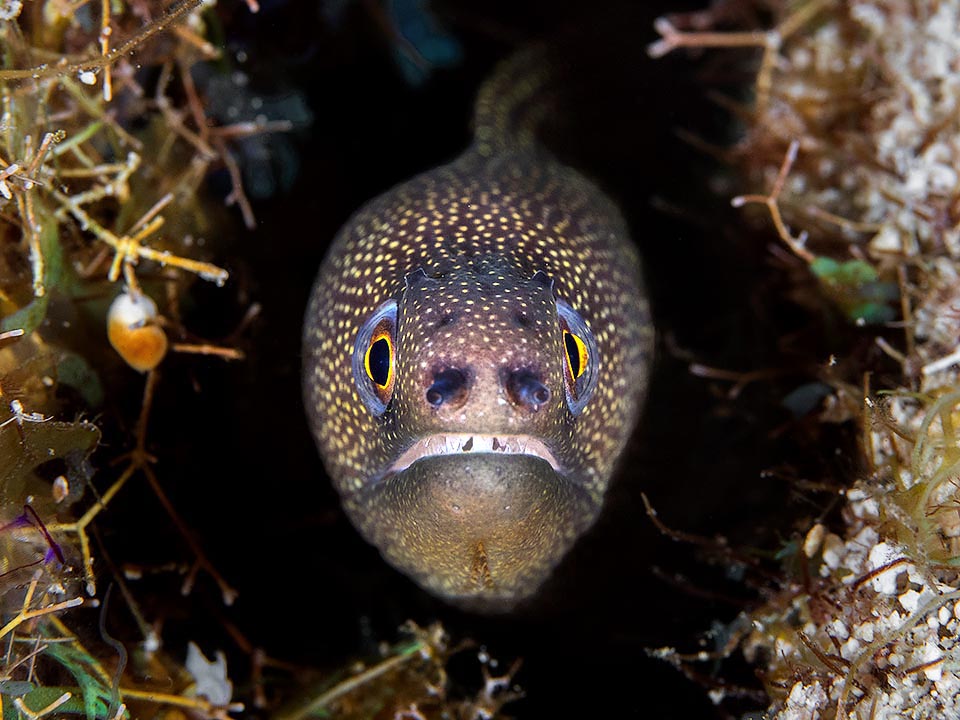
Gymnothorax miliaris is a medium-sized moray present on the two Atlantic coasts mainly in the Caribbean area up to southeast Brazil © Rafi Amar
Just take a look at the synonyms of the Goldentail moray Gymnothorax miliaris ( Kaup, 1856 ), who, due to its graceful appearance is also called Porcelain moray, to understand that it has a very variable livery.
Some Authors, looking at the colour, have called it aurea, golden, or flavopicta, painted yellow, others recall that it is irregolaris, variable, there are those who talk about scriptus, because it has some drawings, or it is multiocellata, because has many ocelli, or myrialeucostictus, with thousands of white spots. The accepted specific name, miliaris, is close to this last vision, stating that the tiny dottings of the livery evokes the tiny grains of millet.
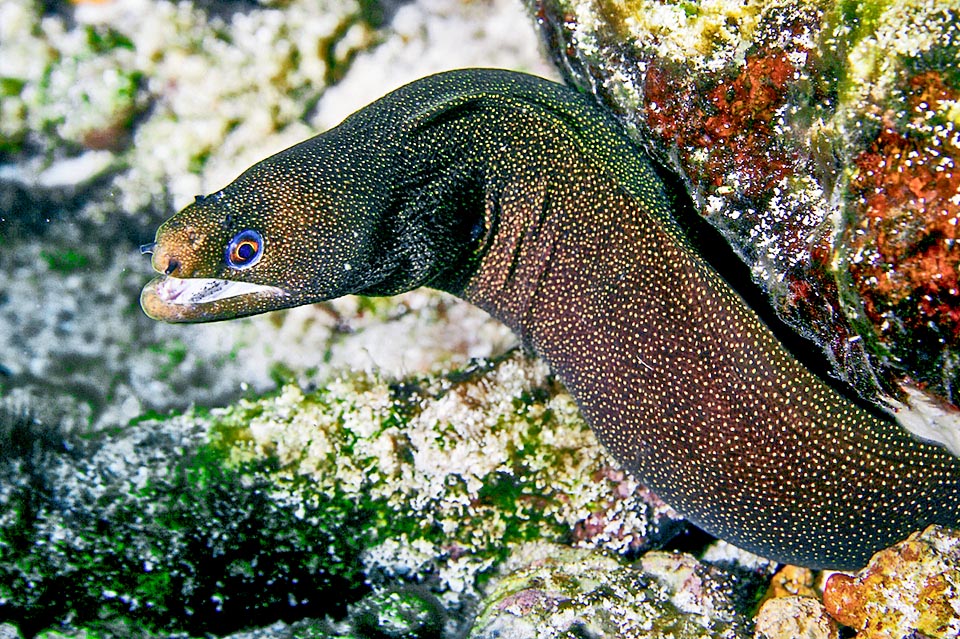
From here, with planktonic larvae carried by the currents, has reached various islands in the ocean middle up to the Cape Verde ones near Africa © Allison & Carlos Estape
The generic term Gymnothorax, given to several morays, from the Greek “gymnos”, naked, and from the Latin “thorax”, thorax, reminds us instead that these fishes, unlike the eels, have naked thorax, without pectoral fins.
So, Gymnothorax miliaris belongs to the class of the Actinopterygii, the ray-finned fishes, and to the family of the Muraenidae, inserted together with that of the Anguillidae in the order of the Anguilliformes.
Zoogeography
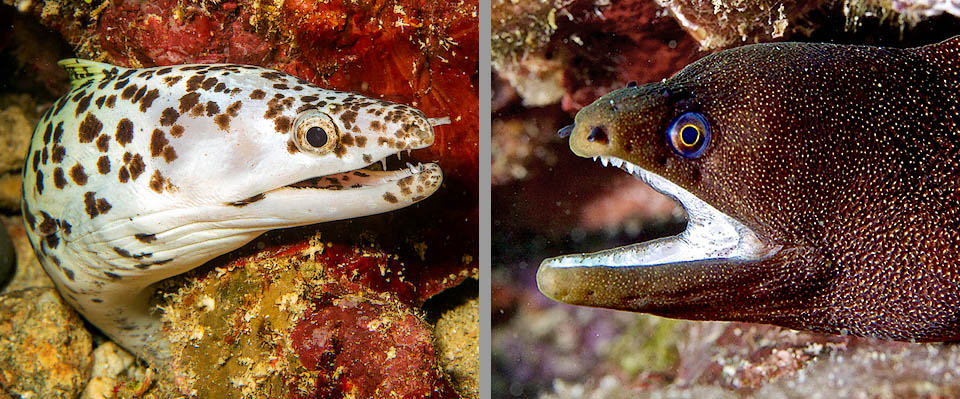
It’s called miliaris due to the tiny dotting of the livery that recalls the millet grains, but as we can note, may be quite different © Allison & Carlos Estape
The Goldentail moray is present in the tropical and subtropical waters along the American Atlantic coasts from Bermudas and Florida to the Antilles and southeast Brazil, but we find it also, carried by the currents, in the middle of the Atlantic Ocean in islands like St. Helen and Ascension and then approaching Africa, in the Cape Verde islands and it seems that it has been sighted also in the Canaries.
Ecology-Habitat
Gymnothorax miliaris lives in the crevices of the coral formations and usually does not descend beyond the 35 m of depth, but is present also in very shallow waters and may reach 60 m.
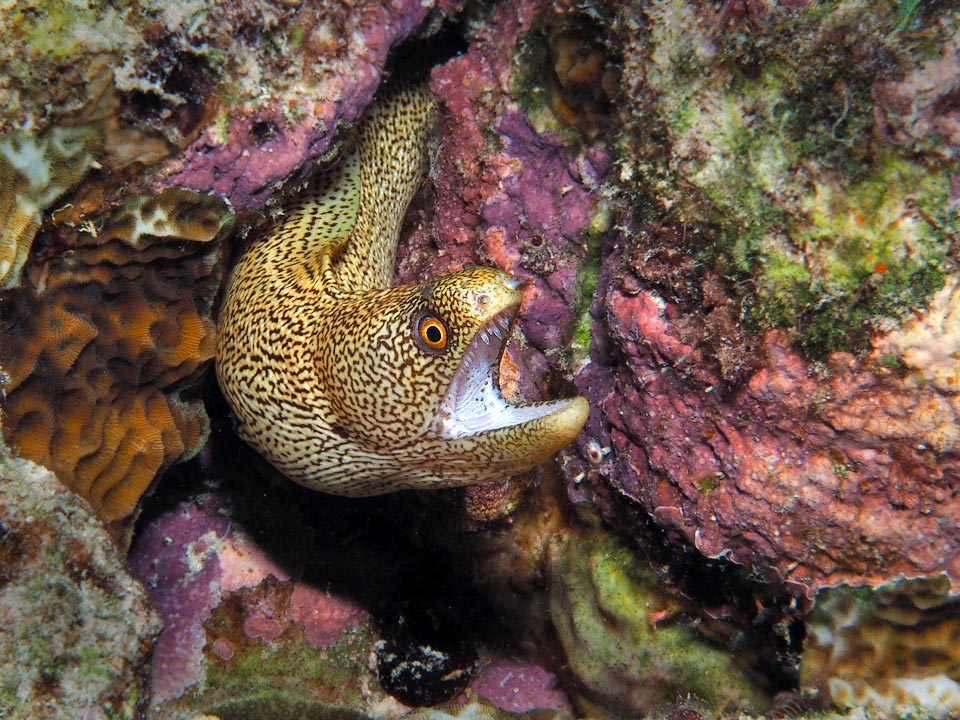
Only certain reference point is the inside part of the mouth that is always white © Pauline Walsh Jacobson
Morphophysiology
The maximum reported length is 70 cm and the current size is about 40 cm.
Like in all Anguilliformes the pelvic fins are absent. The dorsal, caudal and anal ones have merged with each other forming one single long cutaneous crest they use for a wavy swimming.
The gill orifices have been reduced to two simple holes, placed at the end of the head, on the extension of the mouth.
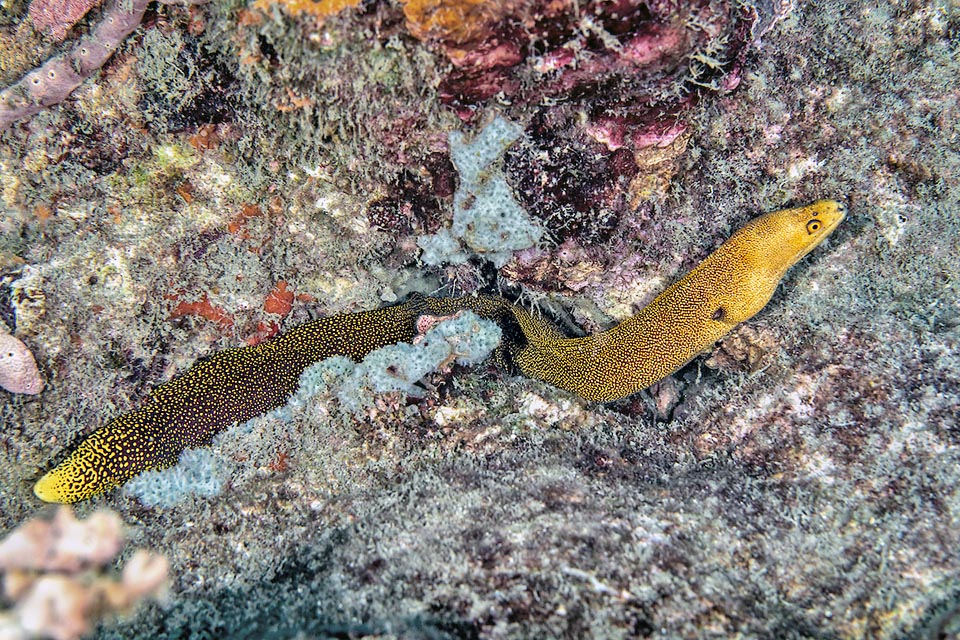
Characteristic is also the tip of the yellow tail more or less evident in the numerous colour variants © Allison & Carlos Estape
Through these the water oxygenating the gills does not enter, but gets out, because the morays take it from the mouth they open and close continuously, not for threatening, then, but for breathing.
One the head we note two tubular nostrils and, just over, two more, less showy. In fact, they are fishes that go hunting mostly in the darkness, based mainly on the sense of smell. The eye, with golden iris, is rimmed in slate blue.
The snout is short and the mouth has numerous rows of thin and conical small teeth present also on the palate for holding and then swallowing the preys.
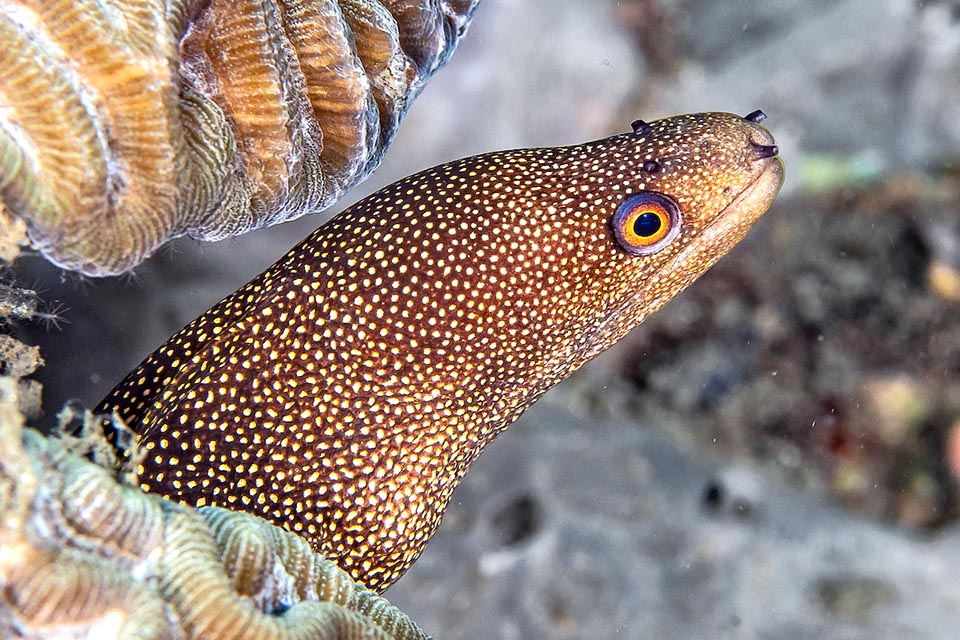
Eyesight is mediocre but sense of smell is excellent. Here we note two fore nostrils and two back at the height of the eye © Allison & Carlos Estape
Like in all morays the scales are missing and the skin is soaked in secreted mucus that protects them from the bacteria and parasites.
The most frequent colour is the dark brown with small yellow dots, small on the head and bigger towards the tail where often they merge forming small hatchings. There is then the opposite scheme with dark small dots on a clear background, and there is also a clear version with a net of drawings or big isolated spots.
Consequently, three basic liveries that perhaps justify also the synonyms of Muraena trinitatis.
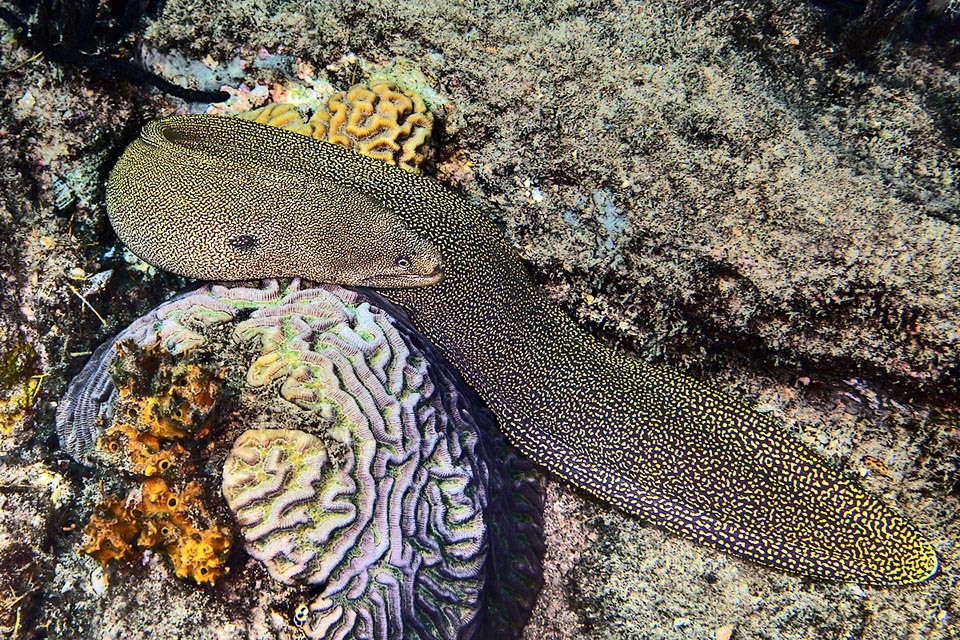
Like in all morays there are no pectoral fins and the others have merged to form one long cutaneous crest used for an undulated swimming © Allison & Carlos Estape
Finally, there is a variant mainly yellow with big spots, called “banana moray”, but luckily in all liveries the inside of the mouth is always typically white, precious element for the identification of the species together with the tip of the tail that, as stated by the vulgar name, is almost always golden.
Ethology-Reproductive Biology
Gymnothorax miliaris feeds chiefly on small crustaceans and mollusks.
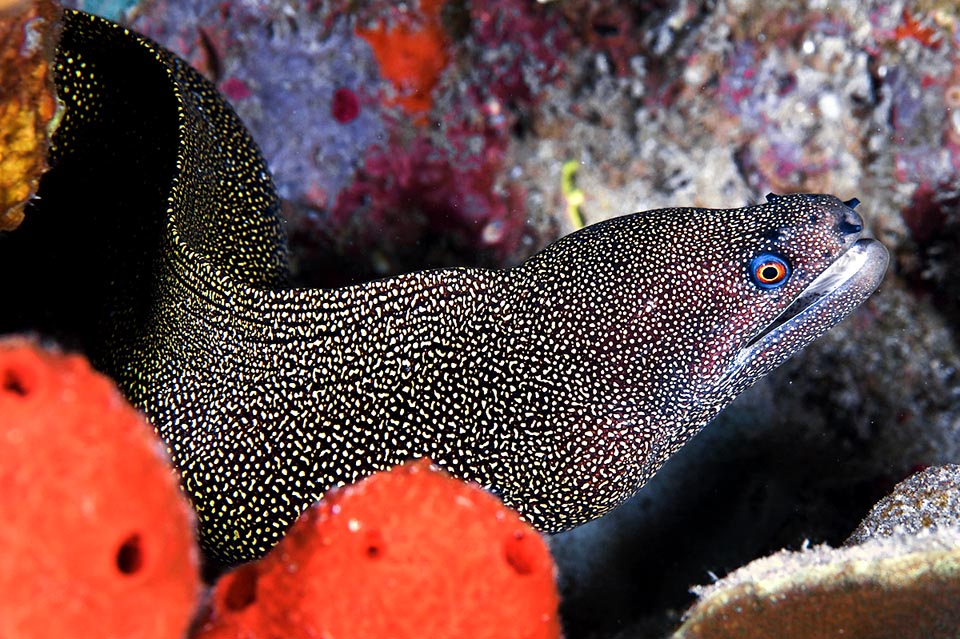
This is the most diffused dark livery. The background colour goes from grey to reddish with small white or yellowish small dots © Allison & Carlos Estape
Usually, it is not fast enough for the small fishes, but when it’s able to catch them they are a welcome variation to the menu.
It hunts mostly at night but is active also during the day hours, sometimes preying, as often happens for the morays, together with small groupers with whom it shares the loot. The eyesight, the sense of smell and the speed thus unite in a team game.
Faithful to its hiding place, the Goldentail moray generally does not get more than 2-3 m away from the den and moves only after weeks if it sees that the preys are decreasing. It lives solitary but at times shares the shelter with other morays.
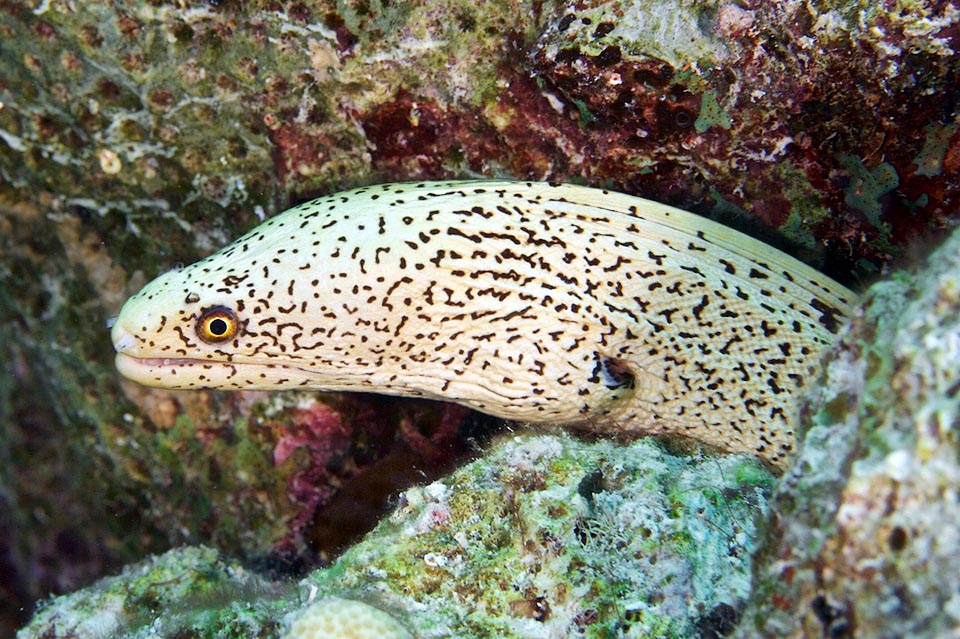
Conversely here we have the inverted livery, clear with dark small dots that at times unite forming a hatching © Allison & Carlos Estape
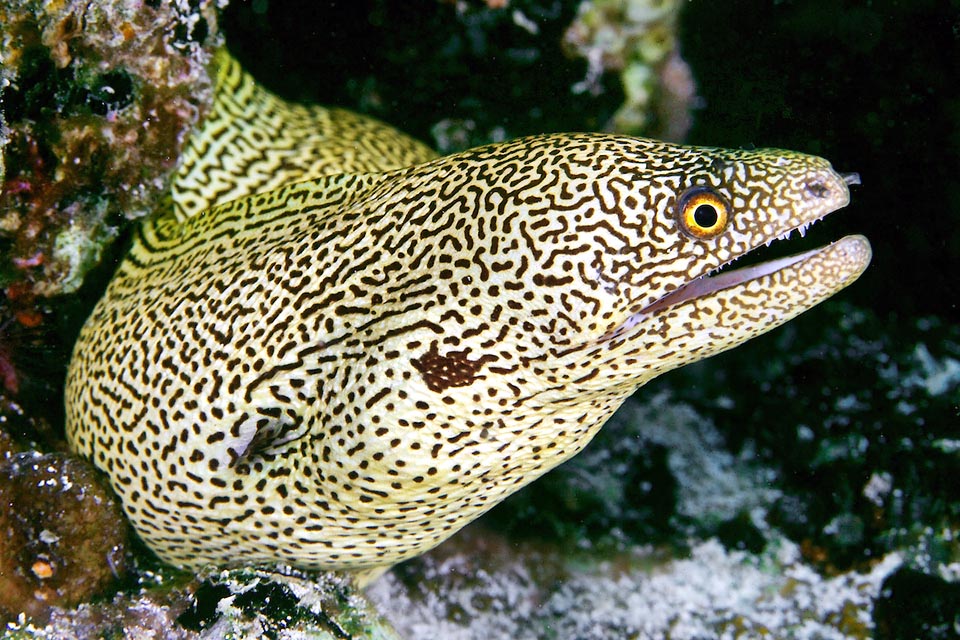
When the hatchings thicken we get this mimetic drawing. In any case they are not instantaneous changes linked to the chromatophores but variants in the species © Allison & Carlos Estape
The reproduction is shrouded in mystery. We just know that it is an oviparous species and that the larvae are leptocephalus, like all anguilliformes.
The resilience of the species is mediocre with a minimal time of 1,4-4,4 years for the doubling of the populations and the fishing vulnerability index marks 48 on a scale of 100. Gymnothorax miliaris since 2011 appears as “Least Concern” in the IUCN Red List evaluation about the endangered species.
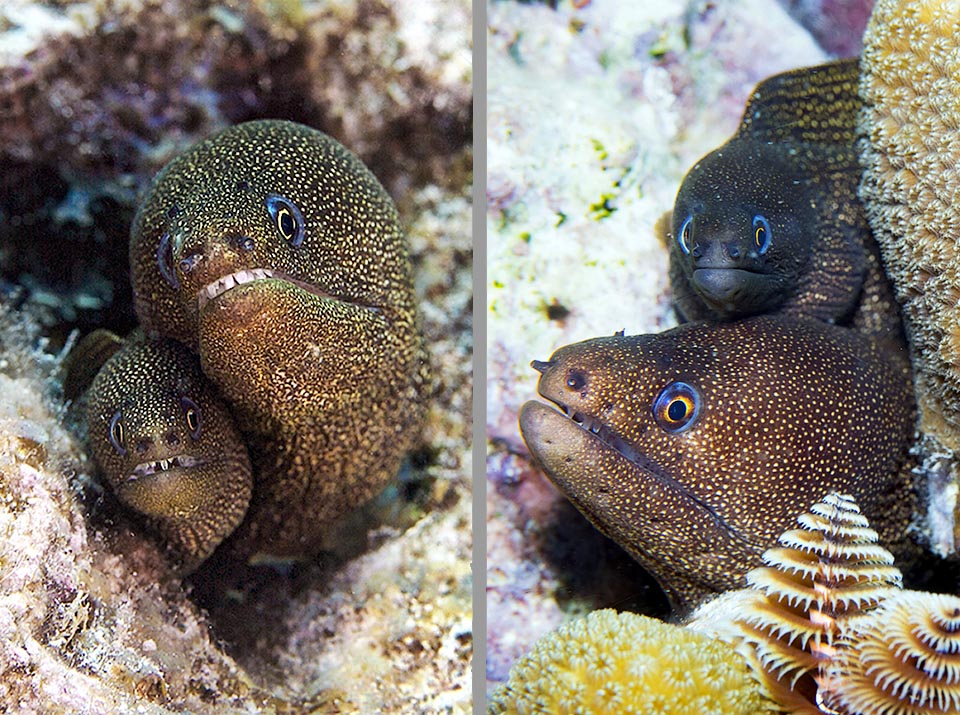
A couple or cohabitation? Little is known about reproduction, but that the eggs are floating and the pelagic larvae called leptocephalus have the pectoral fins like eels © Allison & Carlos Estape
Synonyms
Thrysoidea miliaris Kaup, 1856; Lycodontis miliaris (Kaup, 1856); Muraena miliaris(Kaup, 1856); Murenophis miliaris (Kaup, 1856); Sidera miliaris (Kaup, 1856); Thyrsoidea flavopicta Kaup, 1856; Gymnothorax flavopictus (Kaup, 1856); Lycodontis flavopictus (Kaup, 1856); Muraena flavopicta (Kaup, 1856); Thyrsoidea irregularisKaup, 1856; Gymnothorax irregularis (Kaup, 1856); Lycodontis irregularis (Kaup, 1856); Muraena irregularis (Kaup, 1856); Muraena elaborata Poey, 1860; Gymnothorax elaboratus (Poey, 1860); Lycodontis elaboratus (Poey, 1860); Sidera elaborata (Poey, 1860); Muraena multiocellata Poey, 1860; Gymnothorax scriptus Poey, 1867; Muraena myrialeucostictus Fowler, 1912; Muraena trinitatis Miranda Ribeiro, 1919; Muraena aurea Mowbray, 1931.
→ For general information about FISH please click here.
→ For general information about BONY FISH please click here
→ For general information about CARTILAGINOUS FISH please click here.
→ To appreciate the BIODIVERSITY of BONY FISH please click here.
→ To appreciate the BIODIVERSITY of CARTILAGINOUS FISH please click here.
